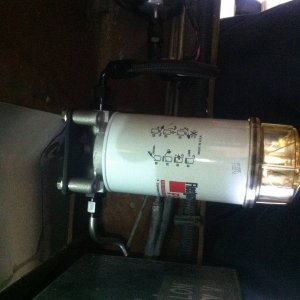AS1 DIAGNOSTIC TROUBLE CODE (DTC) 1661
DTC 1661 indicates that the output circuit check is low.
Possible causes:
-- Low battery voltage
-- Circuit failure
-- Faulty powertrain control module (PCM)
Perform charging system and battery tests.
Is charging system OK?
Yes: GO to «AS2».
No: REPAIR charging system as required.
AS2 VREF CIRCUIT CHECK
Disconnect PCM. Inspect for damaged or pushed out pins, corrosion, loose wires, etc. Service as necessary.
Install breakout box, leave PCM disconnected.
Disconnect manifold absolute pressure (MAP) sensor connector.
Measure resistance from Pin 90 to VREF Circuit 351 (BR/W) at the MAP sensor connector.
Is resistance less than 5 ohms?
Yes: GO to «AS3».
No: IDENTIFY VREF circuit fault. GO to Pinpoint Test «B1».
AS3 VPWR CIRCUIT CHECK
PCM disconnected.
Key on.
Measure resistance from Pins 71 and 97 to the positive battery post.
Is resistance less than 5 ohms?
Yes: GO to «AS4».
No: IDENTIFY VPWR circuit failure. GO to Pinpoint Test «A1».
AS4 PCM GROUND CIRCUIT CHECK
PCM disconnected.
Key off.
Measure resistance from Pins 25, 51, 76, 77 and 103 to the negative battery post.
Is resistance less than 5 ohms?
Yes: REPLACE PCM. RETEST system.
No: REPAIR ground circuit fault. GO to Pinpoint Test «A10».
A1 DIAGNOSTIC TROUBLE CODES (DTCs) 0563/0562/0560: CHECK BATTERY VOLTAGE
Key on, engine off.
Measure voltage across battery terminals.
Is voltage greater than 9.5 volts?
NOTE:
DTC 0563 may be a temporary condition with a 24 volt jump start. DTC 0562 may be a temporary condition at crank only.
0563 -- System voltage high
0562 -- System voltage low
0560 -- System voltage malfunction
Yes: F-Series, GO to «A2». Econoline, GO to «A12».
No: SERVICE discharged battery. REFER to Section 14-00 in Body, Chassis Service Manual.
A2 CHECK VOLTAGE AT MAXI FUSE 9
Measure voltage between maxi fuse 9 at power distribution box to battery negative post.
Is battery voltage present?
Yes: GO to «A3».
No: REPAIR open in Circuit 37 (Y) between the power distribution box and the starter relay.
A3 CHECK MAXI FUSE 9
Check maxi fuse 9 power distribution box.
Is fuse blown?
Yes: REPAIR short to ground and REPLACE maxi fuse 9.
No: GO to «A4».
A4 CHECK CIRCUIT 37 (Y) TO RELAY
Key off.
Remove PCM relay.
Remove maxi fuse 9.
Measure resistance between the nonpower side of the maxi fuse 9 to Circuit 37 (Y) of the PCM relay connector.
Is resistance less than 5 ohms?
Yes: GO to «A5».
No: REPAIR open in Circuit 37 (Y) between fuse and relay connector.
A5 CHECK IGNITION FEED TO DIODE
Remove diode from power distribution box.
Key on.
Measure voltage from battery ground to ignition feed side of diode connector.
Is battery voltage present?
Yes: GO to «A6».
No: REPAIR open in ignition feed Circuit 16 (R/LG) or ignition switch.
A6 CHECK DIODE
Key off.
Disconnect diode.
Does diode check OK?
Yes: F-Series, GO to «A7».
No: REPLACE diode.
A7 CHECK CIRCUIT 175 (BK/Y)
Measure resistance between nonpower side of diode connector Circuit 175 (BK/Y) to PCM relay connector.
Is resistance less than 5 ohms?
Yes: GO to «A8».
No: REPAIR open in Circuit 175.
A8 CHECK GROUND CIRCUIT 57 (BK) AT RELAY
Key off.
Measure resistance between battery negative to Circuit 57 (BK) at PCM relay connector.
Is resistance less than 5 ohms?
Yes: GO to «A9».
No: REPAIR open in Circuit 57 (BK).
A9 CHECK CIRCUIT 361 (R) FROM RELAY TO PCM
Disconnect PCM and inspect for damaged or pushed-out pins, corrosion, loose wires, etc. Service as necessary.
Measure resistance between Circuit 361 (R) at PCM relay connector to Test Pins 71 and 97.
Is resistance less than 5 ohms?
Yes: GO to «A10».
No: REPAIR open in Circuit 361 (R) between relay and PCM.
A10 CHECK PWR GND CIRCUIT CONTINUITY
Key off.
Install breakout box. Leave PCM disconnected. Inspect for damaged or pushed-out pins.
Measure resistance between battery negative post and Test Pins 25, 51, 76, 77 and 103 at the breakout box.
Is each resistance less than 5.0 ohms?
Yes: F-Series, GO to «A11». Econoline, GO to «A14».
No: SERVICE open in PWR GND circuit. REMOVE breakout box. RECONNECT PCM. RERUN Scan Tool Diagnostic Test.
A11 CHECK PCM RELAY
Key off.
Disconnect maxi fuse 9.
Install PCM relay.
Breakout box install, PCM disconnected.
Key on, engine off.
Measure resistance between nonpower side of maxi fuse 9 to Test Pins 71 and 97.
Is resistance less than 5 ohms?
Yes: If fault is still present, REPLACE PCM.
No: REPLACE PCM relay.
B1 CHECK VEHICLE BATTERY POWER CIRCUIT
Key off.
Disconnect PCM. Inspect for damaged or pushed-out pins, corrosion, loose wires, etc. Service as necessary.
Install breakout box and connect PCM to breakout box.
Key on, engine off.
Measure voltage between Test Pins 55, 71 and 97 to Test Pins 25, 51, 76, 77 and 103 at the breakout box. Note voltage.
Measure voltage across battery terminals. Note voltage.
Are both voltages greater than 10.5 volts, and are both voltages within 1.0 volt of each other?
Yes: GO to «B2».
No: Key off, RECONNECT sensor (if applicable).
GO to «A1».
B2 CHECK VREF VOLTAGE
Key on, engine off.
Breakout box installed, PCM connected.
Measure voltage between Test Pin 90 and Test Pin 91 at the breakout box.
Is voltage between 4 volts and 6 volts?
Yes: GO to «B3».
No: Less than 4 volts, GO to «B5». Greater than 6 volts, GO to «B4».
B3 CHECK VREF AND SIG RTN CIRCUITS FOR CONTINUITY
Key off.
Sensor that sent you here disconnected.
Breakout box installed.
Disconnect PCM.
Measure resistance between Test Pin 90 at breakout box and VREF circuit at vehicle harness connector of the sensor that sent you here.
Measure resistance between Test Pin 91 at breakout box and SIG RTN circuit at vehicle harness connector of the sensor that sent you here.
Is each resistance less than 5.0 ohms?
Yes: Reference voltage OK. REMOVE breakout box. RECONNECT all components. RERUN Scan Tool Diagnostic Test.
No: SERVICE open in VREF or SIG RTN circuits. REMOVE breakout box. RECONNECT all components. RERUN Scan Tool Diagnostic Test.
B4 CHECK FOR EXCESS VOLTAGE ON VREF CIRCUIT
Key off.
Breakout box installed.
Disconnect PCM.
Disconnect NGS Tester.
Key on, engine off.
Measure voltage between Test Pin 90 at the breakout box and battery ground.
Is voltage less than 0.5 volts?
Yes: REPLACE PCM. REMOVE breakout box. RECONNECT all components. RERUN Scan Tool Diagnostic Test.
No: SERVICE short to power in vehicle harness. REMOVE breakout box. RECONNECT PCM and sensor. RERUN Scan Tool Diagnostic Test.
B5 SIG RTN CIRCUIT CHECK
Key off.
Breakout box installed.
PCM connected.
Measure resistance between Test Pin 91 and Test Pins 25, 51, 76, 77 and 103 at the breakout box.
Is each resistance less than 5 ohms?
Yes: GO to «B6».
No: REPLACE PCM.
B6 CHECK FOR SHORTED ACCELERATOR PEDAL (AP) SENSOR
Key off.
Breakout box installed, PCM connected.
Disconnect AP sensor from vehicle harness.
Inspect for damaged or pushed-out pins.
Key on, engine off.
Measure voltage between Test Pin 90 and Test Pin 91 at the breakout box.
Is voltage less than 4.0 volts?
Yes: Leave AP sensor disconnected. GO to «B7».
No: REPLACE AP sensor. REMOVE breakout box. RECONNECT all components. RERUN Scan Tool Diagnostic Test.
B7 CHECK FOR SHORTED CAMSHAFT POSITION (CMP) SENSOR
Key off.
Breakout box installed, PCM connected.
Disconnect CMP sensor.
Inspect for damaged or pushed-out pins.
Key on, engine off.
Measure voltage between Test Pin 90 and Test Pin 91 at the breakout box.
Is voltage less than 4.0 volts?
Yes: Leave CMP sensor disconnected. GO to «B8».
No: REPLACE CMP sensor. REMOVE breakout box. RECONNECT PCM and sensors. RERUN Scan Tool Diagnostic Test.
B8 CHECK FOR SHORTED INJECTION CONTROL PRESSURE (ICP) SENSOR
Key off.
Breakout box installed, PCM connected.
Disconnect ICP sensor.
Inspect for damaged or pushed-out pins.
Key on, engine off.
Measure voltage between Test Pin 90 and Test Pin 91 at the breakout box.
Is voltage less than 4.0 volts?
Yes: Leave ICP sensor disconnected. GO to «B9».
No: REPLACE ICP sensor. REMOVE breakout box. RECONNECT PCM and sensor(s). RERUN Scan Tool Diagnostic Test.
B9 CHECK FOR SHORTED EXHAUST BACK PRESSURE (EBP) SENSOR
Key off.
Breakout box installed, PCM connected.
Disconnect EBP sensor.
Inspect for damaged or pushed-out pins.
Key on, engine off.
Measure voltage between Test Pin 90 and Test Pin 91 at the breakout box.
Is voltage less than 4.0 volts?
Yes: Leave EBP sensor disconnected. GO to «B10».
No: REPLACE EBP sensor. REMOVE breakout box. RECONNECT PCM and sensor(s). RERUN Scan Tool Diagnostic Test.
B10 CHECK FOR SHORTED MANIFOLD ABSOLUTE PRESSURE MAP SENSOR
Key off.
Breakout box installed, PCM connected.
Disconnect MAP sensor.
Inspect for damaged or pushed-out pins.
Key on, engine off.
Measure voltage between Test Pin 90 and Test Pin 91 at the breakout box.
Is voltage less than 4.0 volts?
Yes: Leave MAP sensor disconnected. GO to «B11».
No: REPLACE MAP sensor. REMOVE breakout box. RECONNECT PCM and sensor(s). RERUN Scan Tool Diagnostic Test.
B11 CHECK FOR SHORTED BAROMETRIC PRESSURE (BARO) SENSOR
Key off.
Breakout box installed, PCM connected.
Disconnect BARO sensor.
Inspect for damaged or pushed-out pins.
Key on, engine off.
Measure voltage between Test Pin 90 and Test Pin 91 at the breakout box.
Is voltage less than 4.0 volts?
Yes: Leave BARO sensor disconnected. GO to «B12».
No: REPLACE BARO sensor. REMOVE breakout box. RECONNECT PCM and sensor(s). RERUN Scan Tool Diagnostic Test.
B12 CHECK VREF CIRCUIT FOR SHORT TO GROUND
Key off.
Breakout box installed.
Disconnect PCM.
With all six of the three-wire sensors (AP, CMP, ICP, EBP, MAP and BARO) disconnected, measure resistance between Test Pin 90 and Test Pins 25, 51, 76, 77, 91 and 103 at the breakout box.
Are all resistances greater than 10,000 ohms?
Yes: REPLACE PCM. REMOVE breakout box. RECONNECT all components. RERUN Scan Tool Diagnostic Test.
No: SERVICE short to ground. REMOVE breakout box. RECONNECT all components. RERUN Scan Tool Diagnostic Test.












